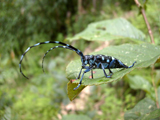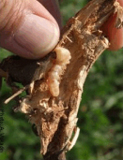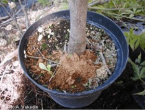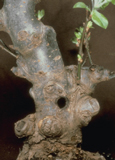Anoplophora chinensis (Citrus long-horned beetle) - Fact Sheet
Background
The citrus long-horned beetle is a wood-boring insect that is native to Asia. The larvae of this beetle can kill trees directly, by damaging the tree, or indirectly, by enabling other pests and diseases to affect the tree.
The beetle gets its name from the damage caused to citrus groves in its native China. However, it feeds on and damages a wide variety of hardwood trees, including many important species found in Canada.
The citrus long-horned beetle is just one species in a genus of damaging pests; the entire genus Anoplophora spp. is included in the Pests Regulated by Canada.
This beetle has been intercepted once entering Canada. However, it has never been found in this country.
The citrus long-horned beetle has been introduced on several occasions into Europe, and has been detected in and subsequently eradicated from the United States.
If citrus long-horned beetle is detected, immediate regulatory measures are taken to contain potential sources of spread. Citrus long-horned beetle is a regulated quarantine pest in Canada and any suspected infestation must be immediately reported to a local CFIA office.
All plants and plant products must meet import procedures in accordance with national policy guidelines under provision of the Plant Protection Act and Regulations when entering Canada.
How does the beetle spread?
Long-distance spread of the citrus long-horned beetle happens mostly through infested nursery plants. This was seen in the European infestation, where it arrived via maple trees. It can also be transported in wood packaging material, firewood, logs and any other wood products made from infested trees. As well, this beetle is capable of flying up to two kilometres.
Biology
In Japan, the adult female lives an average of 77 days and lays up to 300 eggs. These eggs are about the shape and size of a small grain of rice. The adult female beetle chews a T-shaped slit into the plant's trunk, branches or exposed roots, and lays her eggs inside the slit. The eggs hatch inside the plant after one or two weeks.
The hatched young larvae begin feeding on the plant tissue just under the bark. As the larvae mature they bore deeper into the wood, creating tunnels while feeding. Larvae mature in the tunnels and then exit the tree as adults through large round holes. The holes are 10 to 20 millimetres in diameter and are typically near the root collar and on exposed roots.
Depending on the climate, the beetle may take approximately three years to complete its cycle from egg to adult beetle. Because of this, the beetle can remain hidden inside a plant for several years before it emerges.
Detection and identification
The citrus long-horned beetle is very similar in appearance to the Asian long-horned beetle (A. glabripennis). It is large (about 25 to 35 millimetres long) with a shiny black back that is dotted with 10 to 12 white spots.
Because of their relatively large sizes, mature larvae or pupae will most likely be found inside stems and root collars that are several centimetres in diameter. However, in Europe, eggs and young larvae have been detected in branches as small as 10 millimetres (0.4 inches) in diameter.
Hosts
There are over 85 genera of plants, in more than 40 plant families, that can host this beetle. This includes several economically important fruit, forest and ornamental plant species in Canada.
Some of the known host plants common in Canada are
- alder (Alnus spp.)
- apple (Malus spp.)
- ash (Fraxinus spp.)
- birch (Betula spp.)
- hawthorn (Crataegus spp.)
- horse chestnut (Aesculus spp.)
- poplar (Populus spp.)
- beech (Fagus spp.)
- maple (Acer spp.)
- pine (Pinus spp.)
- rose (Rosa spp.)
Signs and symptoms
Signs of this pest on nursery plants could include
- exit holes near the root collar and on exposed roots
- sawdust-like excrement on the surface of the soil
- T-shaped slits on the bark of the lower part of the bole/trunk and on exposed roots
- chewed leaves and scraped bark
On plants where the citrus long-horned beetle is present, but has not completed its life cycle, there may be no visible external signs that the plant is infested.
- Date modified:





